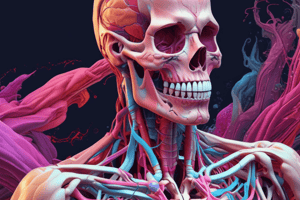Podcast
Questions and Answers
What is one primary function of the muscular system?
What is one primary function of the muscular system?
- Support of body structures
- Protection of organs
- Transport of nutrients
- Production of heat (correct)
Which system is responsible for gas exchange in the human body?
Which system is responsible for gas exchange in the human body?
- Digestive System
- Respiratory System (correct)
- Circulatory System
- Nervous System
Which structure is NOT part of the skeletal system?
Which structure is NOT part of the skeletal system?
- Bones
- Lungs (correct)
- Cartilage
- Ligaments
What is the primary function of the immune system?
What is the primary function of the immune system?
Which organ is part of the urinary system?
Which organ is part of the urinary system?
What is a key function of the endocrine system?
What is a key function of the endocrine system?
Which system provides the framework for support and movement in the body?
Which system provides the framework for support and movement in the body?
Which of the following is NOT a function of the integumentary system?
Which of the following is NOT a function of the integumentary system?
Flashcards are hidden until you start studying
Study Notes
Human Anatomy
1. Overview
- Study of the structure of the human body.
- Divided into macroscopic (gross) and microscopic anatomy.
2. Major Systems
-
Skeletal System
- Comprises bones, cartilage, and ligaments.
- Functions: support, movement, protection of organs, and mineral storage.
-
Muscular System
- Includes skeletal, smooth, and cardiac muscles.
- Functions: movement, stability, and heat production.
-
Circulatory System
- Composed of the heart, blood vessels, and blood.
- Functions: transport of nutrients, gases, and waste.
-
Respiratory System
- Consists of lungs, trachea, and other airways.
- Functions: gas exchange (oxygen and carbon dioxide).
-
Digestive System
- Involves the gastrointestinal tract and accessory organs (liver, pancreas).
- Functions: breakdown of food, nutrient absorption, and waste elimination.
-
Nervous System
- Encompasses the brain, spinal cord, and nerves.
- Functions: coordination of body activities and response to stimuli.
-
Endocrine System
- Made up of glands (e.g., pituitary, thyroid).
- Functions: hormone production and regulation of bodily functions.
-
Immune System
- Involves lymph nodes, spleen, and immune cells.
- Functions: defense against pathogens and disease.
-
Integumentary System
- Comprises skin, hair, nails, and glands.
- Functions: protection, temperature regulation, and sensation.
-
Urinary System
- Includes kidneys, ureters, bladder, and urethra.
- Functions: waste removal and regulation of water and electrolytes.
-
Reproductive System
- Male: testes, prostate, penis.
- Female: ovaries, uterus, vagina.
- Functions: production of gametes and hormones, reproduction.
3. Anatomical Terminology
-
Directional Terms
- Superior: toward the head
- Inferior: toward the feet
- Anterior (ventral): front
- Posterior (dorsal): back
- Medial: toward the midline
- Lateral: away from the midline
- Proximal: closer to the trunk
- Distal: farther from the trunk
-
Body Planes
- Sagittal: divides body into left and right
- Coronal (frontal): divides body into anterior and posterior
- Transverse (horizontal): divides body into superior and inferior
4. Developmental Anatomy
- Embryology: study of development from fertilization to birth.
- Key stages: zygote, embryo, fetus.
5. Clinical Anatomy
- Application of anatomical knowledge in medicine.
- Importance in diagnosis and surgical procedures.
Overview of Human Anatomy
- Human anatomy focuses on the structure of the body, classified into macroscopic (gross) and microscopic anatomy.
Major Systems
-
Skeletal System
- Comprises bones, cartilage, and ligaments; provides support, facilitates movement, protects organs, and stores minerals.
-
Muscular System
- Includes skeletal, smooth, and cardiac muscles; responsible for movement, maintaining stability, and generating heat.
-
Circulatory System
- Made up of the heart, blood vessels, and blood; facilitates the transport of nutrients, gases, and waste products throughout the body.
-
Respiratory System
- Consists of lungs, trachea, and additional airways; performs gas exchange by providing oxygen and removing carbon dioxide.
-
Digestive System
- Encompasses the gastrointestinal tract and accessory organs like the liver and pancreas; involved in food breakdown, nutrient absorption, and waste elimination.
-
Nervous System
- Composed of the brain, spinal cord, and nerves; coordinates bodily functions and responds to internal and external stimuli.
-
Endocrine System
- Comprised of various glands such as the pituitary and thyroid; produces hormones that regulate numerous bodily functions.
-
Immune System
- Involves lymph nodes, the spleen, and immune cells; protects the body against pathogens and diseases.
-
Integumentary System
- Includes skin, hair, nails, and glands; provides protection, regulates temperature, and facilitates sensation.
-
Urinary System
- Consists of kidneys, ureters, bladder, and urethra; crucial for waste removal and maintaining water and electrolyte balance.
-
Reproductive System
- Male reproductive organs: testes, prostate, penis. Female reproductive organs: ovaries, uterus, vagina; responsible for gamete production, hormone secretion, and reproduction.
Anatomical Terminology
-
Directional Terms
- Superior: toward the head
- Inferior: toward the feet
- Anterior (ventral): front
- Posterior (dorsal): back
- Medial: toward the midline
- Lateral: away from the midline
- Proximal: closer to the trunk
- Distal: farther from the trunk
-
Body Planes
- Sagittal: divides the body into left and right halves
- Coronal (frontal): splits the body into anterior and posterior sections
- Transverse (horizontal): separates the body into superior and inferior parts
Developmental Anatomy
- Embryology examines development from fertilization to birth; key stages include zygote, embryo, and fetus.
Clinical Anatomy
- The application of anatomical knowledge in the medical field is crucial for diagnosis and surgical procedures.
Studying That Suits You
Use AI to generate personalized quizzes and flashcards to suit your learning preferences.





